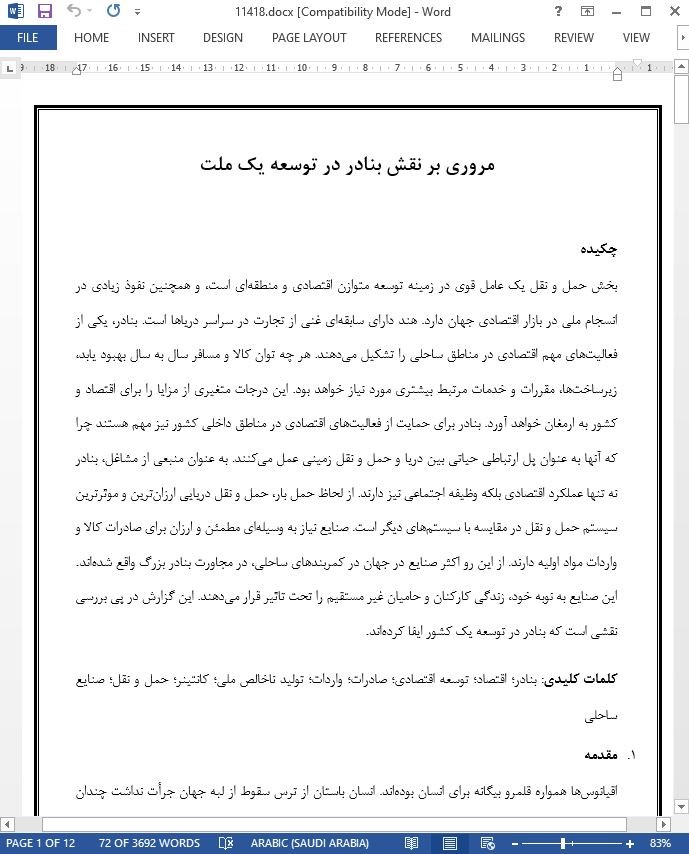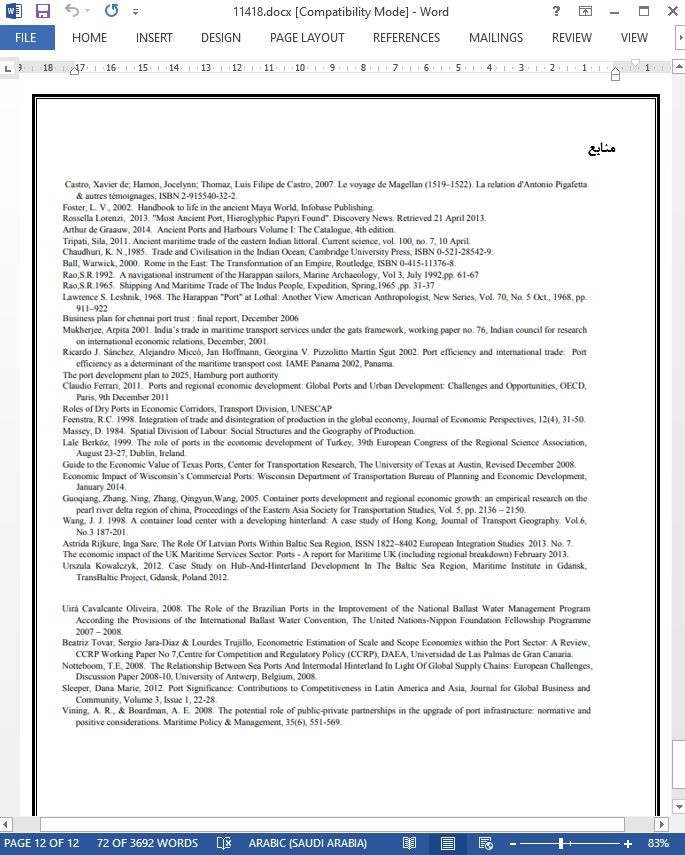
مروری بر نقش بنادر در توسعه یک ملت
چکیده
بخش حمل و نقل یک عامل قوی در زمینه توسعه متوازن اقتصادی و منطقه ای است، و همچنین نفوذ زیادی در انسجام ملی در بازار اقتصادی جهان دارد. هند دارای سابقه ای غنی از تجارت در سراسر دریاها است. بنادر، یکی از فعالیت های مهم اقتصادی در مناطق ساحلی را تشکیل می دهند. هر چه توان کالا و مسافر سال به سال بهبود یابد، زیرساخت ها، مقررات و خدمات مرتبط بیشتری مورد نیاز خواهد بود. این درجات متغیری از مزایا را برای اقتصاد و کشور به ارمغان خواهد آورد. بنادر برای حمایت از فعالیت های اقتصادی در مناطق داخلی کشور نیز مهم هستند چرا که آنها به عنوان پل ارتباطی حیاتی بین دریا و حمل و نقل زمینی عمل می کنند. به عنوان منبعی از مشاغل، بنادر نه تنها عملکرد اقتصادی بلکه وظیفه اجتماعی نیز دارند. از لحاظ حمل بار، حمل و نقل دریایی ارزان ترین و موثرترین سیستم حمل و نقل در مقایسه با سیستم های دیگر است. صنایع نیاز به وسیله ای مطمئن و ارزان برای صادرات کالا و واردات مواد اولیه دارند. از این رو اکثر صنایع در جهان در کمربندهای ساحلی، در مجاورت بنادر بزرگ واقع شده اند. این صنایع به نوبه خود، زندگی کارکنان و حامیان غیر مستقیم را تحت تاثیر قرار می دهند. این گزارش در پی بررسی نقشی است که بنادر در توسعه یک کشور ایفا کرده اند.
1. مقدمه
اقیانوس ها همواره قلمرو بیگانه برای انسان بوده اند. انسان باستان از ترس سقوط از لبه جهان جرأت نداشت چندان در اقیانوس ها پیش برود. با پیشرفت علم، انسان شروع به درک مطالب بیشتری در مورد این جهان ناشناخته کرد. تمدن های باستان روابط تجاری بین شهرهای ساحلی داشتند. باور قدیمی زمانی که ثابت شد سیاره زمین لبه ندارد با توجه به کاسترو و همکاران (1970) در هم شکست.
4. بحث و نتیجه گیری
نتایج گزارشات مختلف از بنادر سراسر جهان به وضوح این ایده را مطرح می کند که بنادر بخش حیاتی از اقتصاد کشور هستند. رشد بنادر فورا رشد اقتصاد کشور را تقویت خواهد کرد. رشد و توسعه بنادر منجر به فعالیت بیشتر تجارت، افزایش عرضه، ذخایر خارجی بیشتر و کاهش قیمت کالا می شود. بهبود زیرساخت های بندر بازتاب بسیار خوبی در تولید ناخالص داخلی در موارد بحث شده نشان داده است.
Abstract
The transportation sector is a strong factor in terms of economic and regional balanced development, as well as also having a great influence on national integration to the world economic market. India has a rich history of trade across seas. Ports constitute an important economic activity in coastal areas. The higher the throughput of goods and passengers year-on-year, the more infrastructure, provisions and associated services are required. These will bring varying degrees of benefits to the economy and to the country. Ports are also important for the support of economic activities in the hinterland since they act as a crucial connection between sea and land transport. As a supplier of jobs, ports do not only serve an economic but also a social function. In terms of load carried, seaway transportation is the cheapest and most effective transportation system compared to other systems. Industries require a safe and cheap means of exporting finished goods and importing raw materials. Hence the majority of industries in the world are located in the coastal belts, in the vicinity of major ports. These industries in turn, influence the lives of the employees and indirect benefactors. This report seeks to study the role played by ports in the development of a nation.
1. Introduction
Oceans have always been an alien realm for humans. Ancient humans dared not sail too far into the ocean for fear of falling off the edge of the world. As science progressed, humans began to understand more about this unknown world. Ancient civilizations had trade relations between the coastal cities. The age old belief was broken when the planet was proven not to have edges according to Castro et al. (1970).
4. Discussion and Conclusions
Results of the various reports from ports around the world clearly put forth the idea that ports are a vital part of a country’s economy. The growth of ports will unerringly boost the country’s economy. The growth and development of ports leads to greater trade activity, increased supply, greater foreign reserves and reduced prices for commodities as a whole. Improvement in the port infrastructure has shown very good reflections in the GDP in the cases discussed.
چکیده
1. مقدمه
2. بنادر
3. اثرات اقتصادی
4. بحث و نتیجه گیری
Abstract
1. Introduction
2. Ports
3. Economic Impacts
4. Discussion and Conclusions
- اصل مقاله انگلیسی با فرمت ورد (word) با قابلیت ویرایش
- ترجمه فارسی مقاله با فرمت ورد (word) با قابلیت ویرایش، بدون آرم سایت ای ترجمه
- ترجمه فارسی مقاله با فرمت pdf، بدون آرم سایت ای ترجمه


